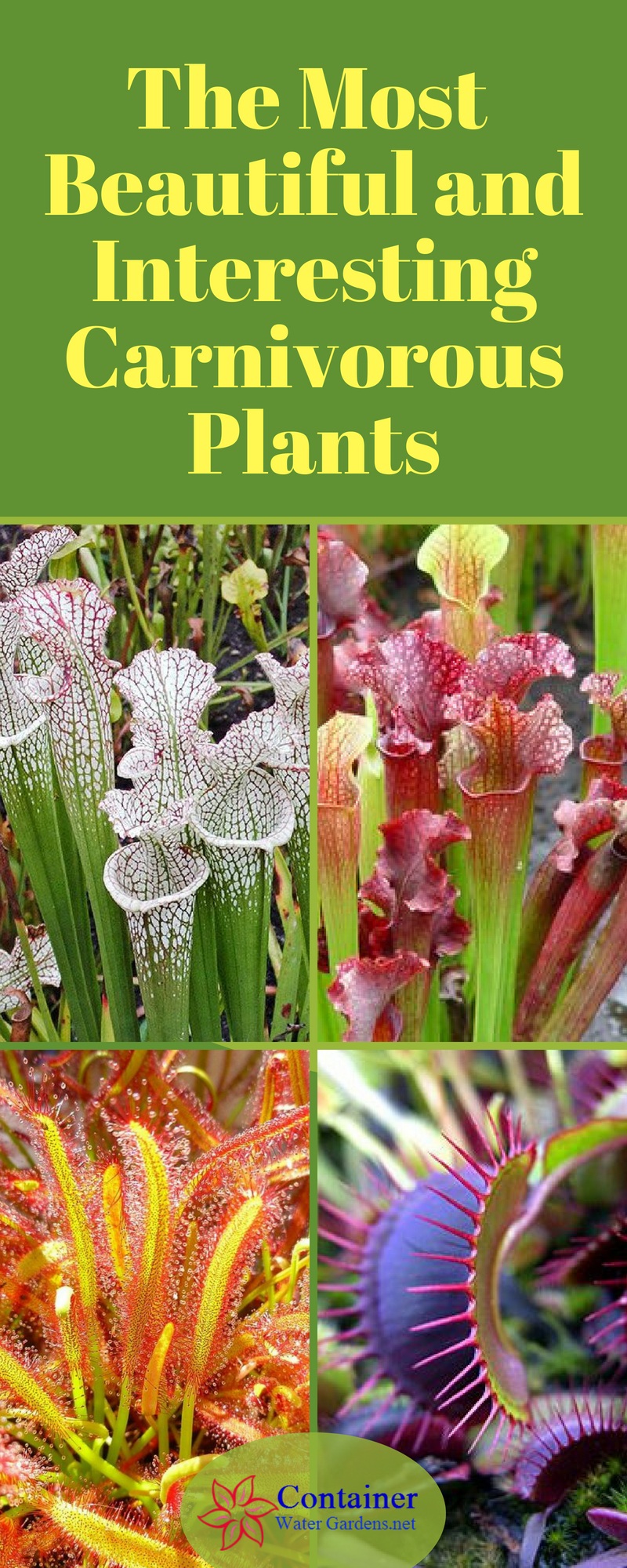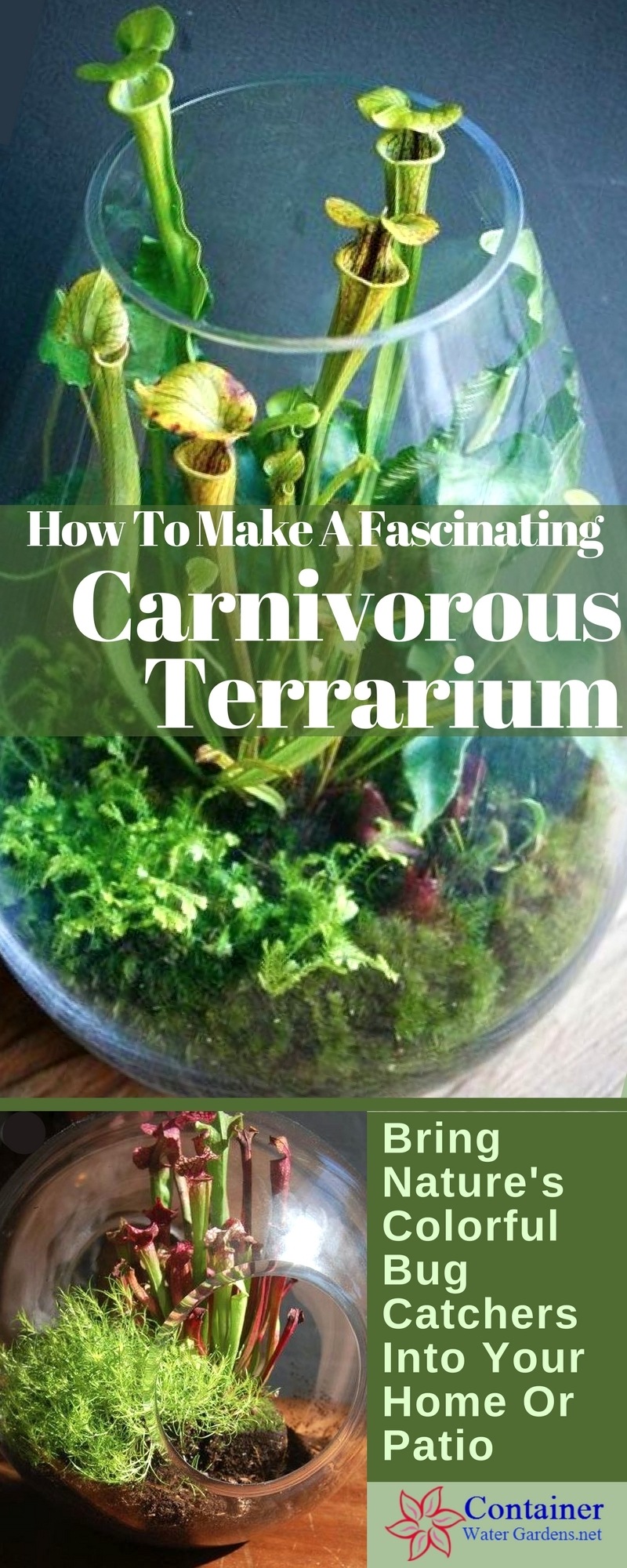
Terrariums are pretty easy to create and care for, you may have made one in school as a science class project. Carnivorous plants will “eat” flies, ants, and wasps when placed outdoors plus they come in many colorful shapes and sizes. Watching them catch bugs adds even more interest. Pitcher plants alone have a variety of beautiful colors, but to add even more variety, I’ll also cover the necessary growing conditions for Venus fly traps and Sundew plants.
The Terrarium
You will need a taller terrarium/clear vase (at least 10 inches) with a narrow or small opening at the top. The opening will allow air movement so the roots do not rot and let in the occasional small insect.
Art and crafts stores and home decor stores sell them. It’s also a good idea to have a cover with a shallow water collection dish bottom because pitcher plants prefer to keep their bottom roots wet.
Growing Medium
Pitcher plants have to be rooted in a layer of sand covered in a layer of sphagnum peat moss. The sand keeps their roots moist and the peat moss looks nice and keeps the sand from drying between waterings. Pitcher plants naturally grow in poor wet sandy (bog type) soils and get most of their nutrients from digesting bugs. Do not use sand from home centers for construction due to the impurities it often has, pitcher plants are very sensitive to them. Instead, use pure quarts sand like pool filter sand.
For venus fly traps and sundew plants you can add a some potting soil to the sand layer for their part of the terrarium. Watering for these plants will be much the same as they are for pitcher plants.
Watering
Again because of the pitcher plant’s intolerance for impurities you should not use water from the tap. It contains chlorine and fluoride. Instead collect some rain water or use bottled drinking water. Check the bottom of your terrarium at least every 2 days to see if it’s drying out, daily if they’re in the sun at all. Pitcher plants grow in bog environments in the wild and like to keep their “feet” wet, so make sure to keep the sandy layer wet and the peat moss on the dry side so they will not get root rot. I do not recommend fertilizing them. Pitchers like a high humidity. Mist the plants if you live in a dry climate or have them in the sun.

Top right and left: a white and a red pitcher plant (Sarracenia species), bottom left: sundew plant (Drosera sp.), bottom right: venus fly trap (Dionaea sp.).
Pitcher Plants, Venus Fly Traps, and Sundew Plants
It is important to note that there are two very different types of what are commonly called “pitcher plants”. The larger, tropical pitcher plant (Nepenthes species) are larger plants often grown in greenhouses and have very large pitchers that can hang from the plants when placed in hanging baskets. The type of pitcher plants for use in terrariums in this article are the hardy pitcher plants (Sarracenia species), not the tropical ones. Hardy pitcher plants have long cylindrical tubes for “pitchers” which rise above the foliage of the plant and have a “hood” covering on top (see pictures below).
Pitcher plants trap bugs with small hairs inside the pitcher that point downwards so the bugs pass down too far past the opening, they can’t climb back out. The bottom of the pitcher contains a digestive fluid that liquefies the bugs.
Venus fly traps (Dionaea Muscipula) have small hair-triggers inside, when flies touch the trigger the trap (and teeth) shuts with the fly inside. The more hairs that are triggered, the faster and tighter the plant shuts on insects that try to struggle out. Once inside, the plant secrets an enzyme that digests the insect.
Sundew plants (Drosera species) are also very interesting in how they capture insects. Sundews are covered in small hairs with a very sticky liquid on them. Once an insect lands on them, the octopus-like tendrils wraps around it trapping it in the sticky liquid which of course, is also a digestive fluid.
Do Carnivorous Plants Need Insects To Survive?
The short answer is yes. Carnivorous plants get most of their nutrients this way. They should be okay if you’re keeping them out doors. If you keep your terrarium indoors I would take it out on porch or patio every now and then that is not screened on warm days.
If you would like to see more carnivorous varieties and some outdoor container bog gardens (a great way to grow these plants outdoors), see our Carnivorous Terrariums board on Pinterest.

PIN ME!!!
